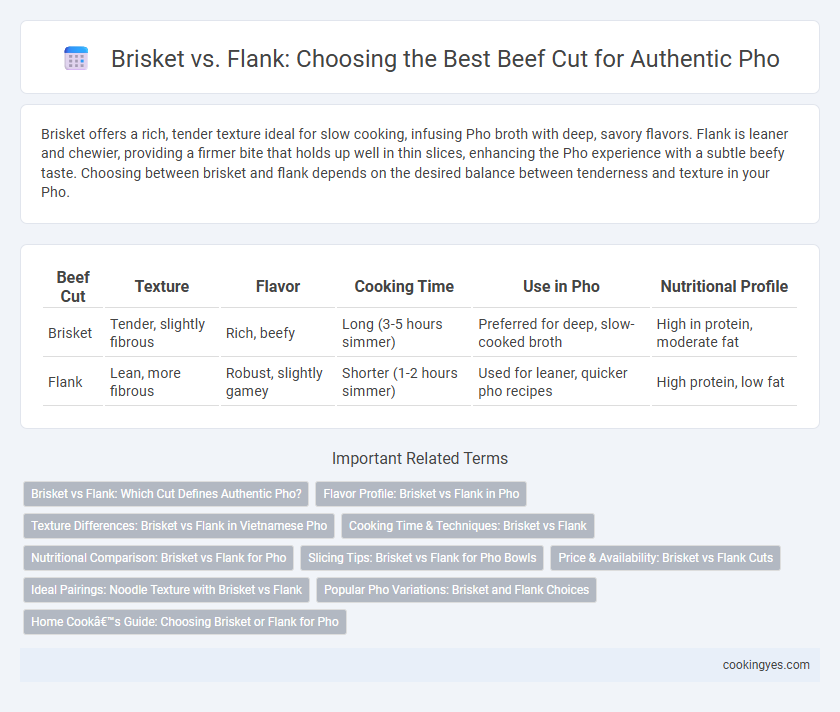Brisket offers a rich, tender texture ideal for slow cooking, infusing Pho broth with deep, savory flavors. Flank is leaner and chewier, providing a firmer bite that holds up well in thin slices, enhancing the Pho experience with a subtle beefy taste. Choosing between brisket and flank depends on the desired balance between tenderness and texture in your Pho.
Table of Comparison
| Beef Cut | Texture | Flavor | Cooking Time | Use in Pho | Nutritional Profile |
|---|---|---|---|---|---|
| Brisket | Tender, slightly fibrous | Rich, beefy | Long (3-5 hours simmer) | Preferred for deep, slow-cooked broth | High in protein, moderate fat |
| Flank | Lean, more fibrous | Robust, slightly gamey | Shorter (1-2 hours simmer) | Used for leaner, quicker pho recipes | High protein, low fat |
Brisket vs Flank: Which Cut Defines Authentic Pho?
Brisket is widely regarded as the defining cut for authentic pho, prized for its rich marbling and tender texture that infuses the broth with deep, savory flavors. Flank, while leaner and slightly chewier, offers a lighter taste that appeals to those seeking a less fatty option but lacks the full-bodied essence achieved by brisket. Traditional Vietnamese pho recipes predominantly feature brisket to achieve the characteristic balance of tenderness and flavor that defines the dish.
Flavor Profile: Brisket vs Flank in Pho
Brisket in pho offers a rich, tender texture with a deep, beefy flavor that infuses the broth with savory complexity. Flank provides a leaner, slightly chewier bite with a milder taste that absorbs the aromatic spices of the pho broth more subtly. Choosing brisket enhances the broth's richness, while flank offers a delicate balance that highlights the broth's herbal notes.
Texture Differences: Brisket vs Flank in Vietnamese Pho
Brisket in Vietnamese Pho offers a tender, melt-in-the-mouth texture due to its higher fat content and marbling, which breaks down slowly during simmering. Flank, on the other hand, provides a firmer, chewier bite with more pronounced muscle fibers, contributing a leaner texture that contrasts with the broth's softness. The choice between brisket and flank influences the Pho experience by balancing richness versus chewiness, catering to different texture preferences.
Cooking Time & Techniques: Brisket vs Flank
Brisket requires long, slow cooking methods such as braising or simmering for 3 to 4 hours to break down tough connective tissues and achieve tender, flavorful meat. Flank, on the other hand, cooks much faster, typically 5 to 10 minutes when grilled or seared, benefiting from quick, high-heat techniques to maintain its lean texture and prevent toughness. For pho broth, brisket adds richness and depth through slow cooking, while flank offers a leaner, more delicate beef option with minimal cooking time.
Nutritional Comparison: Brisket vs Flank for Pho
Brisket and flank beef cuts vary significantly in their nutritional profiles for pho. Brisket is higher in fat content, providing richer flavor and tender texture, but also contributes more calories and saturated fat. Flank is leaner with lower fat and calorie counts, making it a healthier option while still offering a robust beef taste ideal for pho broth.
Slicing Tips: Brisket vs Flank for Pho Bowls
Brisket for pho bowls requires thin, uniform slicing against the grain to ensure tenderness and a melt-in-mouth texture, while flank benefits from slightly thicker cuts sliced across the grain to maintain juiciness and a balanced chew. Using a sharp, flexible knife enhances precision and preserves the meat's natural juices, critical for achieving pho's signature delicate mouthfeel. Proper slicing optimizes flavor absorption and tenderness, highlighting the distinct textures of brisket and flank in the broth.
Price & Availability: Brisket vs Flank Cuts
Brisket is typically more expensive than flank due to its longer cooking time and higher fat content, which enhances flavor and tenderness in pho broth. Flank cuts are more affordable and widely available, often favored for their leaner profile and quicker preparation. Both cuts provide distinct textures that influence pho's overall taste, but brisket's price reflects its premium quality in traditional Vietnamese cuisine.
Ideal Pairings: Noodle Texture with Brisket vs Flank
Brisket pairs exceptionally well with flat rice noodles due to its rich, fatty texture that softens as it simmers, complementing the noodles' smooth, tender bite. Flank steak, with its leaner and firmer texture, is ideal for thinner, chewier noodles like egg noodles, providing a satisfying contrast that enhances the overall pho experience. The interplay between brisket's melt-in-your-mouth softness and flank's hearty chew defines the nuanced noodle pairing in traditional Vietnamese pho.
Popular Pho Variations: Brisket and Flank Choices
Brisket and flank are two popular beef cuts in pho, each offering distinct textures and flavors that influence the soup's character. Brisket provides a tender, juicy bite with rich marbling, making it ideal for slow-cooked pho broth absorption. Flank, leaner and firmer, adds a slightly chewy texture and a robust beefy taste favored in many traditional Vietnamese pho recipes.
Home Cook’s Guide: Choosing Brisket or Flank for Pho
Brisket offers rich marbling and a tender texture, ideal for slow-simmered pho broth, delivering deep, beefy flavors. Flank, leaner and more fibrous, cooks faster, providing a slightly chewier bite that absorbs pho spices well. Home cooks should select brisket for traditional pho depth or flank for a lighter, quicker-cooking option enhancing broth clarity.
Brisket vs flank for beef cut Infographic

 cookingyes.com
cookingyes.com